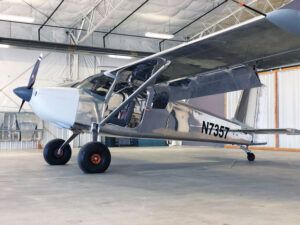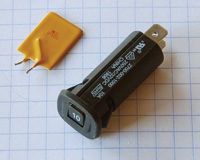Van’s Aircraft, which filed for Chapter 11 bankruptcy protection on December 4, was back in court on December 19 to get approval to use cash on hand to run the business day to day while the reorganization proceeds and to allow it to accept outside funding, in this case from founder Dick VanGrunsven’s family trust. Both motions were unopposed and approved by Judge David Hercher.
Later that day, we had a chance to interview Clyde Hamstreet, whose company, Hamstreet & Associates, specializes in recovering companies in distress.
What does Hamstreet & Associates do?

Our company works with those having financial troubles, usually from operations or balance sheet issues. We also work with companies that don’t have a management structure to help them build one. Over the years, dealing with companies in crisis, one of the tools we use is reorganization through Chapter 11 or sometimes state receiverships. The first thing was an assessment of the business. We need to know what we have to work with and understand the prospects going forward. You don’t want to file Chapter 11 and then find out it’s not going to work and it gets converted to a Chapter 7 [liquidation].
How did you and your company get involved with Van’s?
Dick VanGrunsven had already brought in two people I didn’t know, the interim CEO Mikael Via and Don Eisele. Don has been a CFO for manufacturing companies and is very experienced. He built his own RV-14. He offered to apply his skills to help Van’s out. They realized that the problems at the company were bigger than they thought and they contacted us through another party.
What were your first steps in the recovery plan for Van’s?
We changed the corporate governance, which is where you start. One of my people, Mark Schmidt, was appointed as COO, Don was appointed CFO, Mikael was appointed CEO and I was appointed CRO, chief restructuring officer. Then we knew who was responsible for what and we began our assessment. When we were finished we looked at it and felt that it has a lot of value, the balance sheet is not bad but its cash flow is all messed up. We don’t have a lot of cash because of one-off losses we had. After that assessment we looked at our inventory and other factors and decided it was a good candidate for Chapter 11 reorganization. We need to have some time to get through this and price increases that have to happen all at one time, and Chapter 11 is a good vehicle for that.
Van’s was filed under Chapter 11, subchapter V. Why was that chosen?
Chapter 11s are expensive propositions. You have creditors’ committees, and the lawyers for the creditors’ committees have to be paid for by the debtor. Plus there’s a lot of give and take around the reorganization plan, and a lot of hearings. They’re expensive. Sub-fives eliminate the creditors’ committees, reduce legal costs and uses a single trustee that helps the debtor put together a plan. The advantages are that you have to have a plan in 90 days, and if it’s found to be compliant with the law and makes sense to the judge, he’ll approve it and you’re in and out [of Chapter 11] quickly.
But with subchapter V, you can’t have debts in excess of $7.5 million, but you don’t count insiders. So in this case, there was a lot of debt to Van and his family that doesn’t count.
Is there a downside for consumers in Subchapter V?
Generally, what you’re able to pay creditors is what’s left over in a reorganization. And that’s one of the advantages of not having a lot of cost and you can get through it quicker. So consumers are usually better off.
On December 19, 2023, you had the second hearing in front of Judge Hercher. What happened and how do you feel it went?
Two things were dealt with today. One was the permanent use of cash collateral. The first hearing gave us temporary use, which allows you to pay your bills and operate in normal course. In this hearing, there was no opposition so the judge approved our plan. The second and more important motion was the ability of Van’s Aircraft to borrow up to $6 million to use as it needs to get through this process. Van’s family has agreed to loan us that $6 million. There was no opposition and that motion was approved.
[Note: Both hearings were made publicly available live by Zoom and participants were asked if they were opposed to several measures. No one voiced disapproval.]
The company had begun to notify customers on Monday, December 18, that prices were going up and asked them to approve of a new purchase agreement.
Under the bankruptcy code, you are allowed to terminate contracts or modify those contracts if the other party is agreeable. We have a lot of contracts for those who have purchased kits or parts. We have the Ombudsman Motion, which allows us to modify those contracts. If the buyer and seller don’t agree to that modification, then Van’s would have the authority to terminate those contracts.The person holding that contract would have a claim.
We started off with approximately 550 live customers on a live portal to make sure nothing would break down. We were pleased that out of those first customers who got notice, more than 60% of them said, “Yes, I’d like to renew my contract at the revised price and terms.”
If the first group was 550 people, approximately, how large is the entire group?
I think it’s about 1500 for kits only. We still need to work out [a plan] for those people who order engines and propellers and avionics, or other third-party parts. We obviously can’t raise those prices like we have on the kits.
What is the deadline for builders to respond before their contracts are unilaterally canceled?
The deadline we originally discussed was January 15, 2024, but because it took us a little longer to get the web page lined up, we extended the date to January 30. And the court was fine with that today.
What’s the timeline for advising customers on deposits placed for engines, propellers and avionics?
We haven’t focused on that as much yet. We’ve focused mainly on the kit side. I’d guess it’ll be after the holidays, most likely late January.
What are the steps after that and timelines going forward?

We’ll know more as we know how many customers have accepted the revised terms, and how many new customers we might get through the first part of February. Based on that, we can make some reasonable projections on what our revenue is expected to be for the next three years. We know we’re going to introduce the RV-15 at some point in time, and we expect to get a certain amount of sales there. We’ll have a pretty good idea of what our expenses are based on the work we’re doing now. Based on that we’ll have projected earnings, and the earnings over the next three to five years are the funds we use to repay our investors and continue to grow the company.
What is the timeline for potential recovery for those who decline the new agreements?
You’re going to know a lot more come April, when we have a plan filed and everyone sees it. It’ll all be made public. I’ve never had a company file a plan where people weren’t paid back in five years. Many plans have 100% plans. Some have offers of cash or equity, and those who took equity did very well. But we can’t speculate much more until we know what the customer response is going to be.
How does recovery from the laser cut parts factor into your planning?
I think we’re going to have that nailed down within the next two to three weeks.
What’s the sense of when a company like this can get “back to normal?”
I think with marked improvements in operating efficiencies—things we can improve to make us a smoother, more efficiency company—we’ll be stabilized by early summer.
What processes are in place to keep Van’s from repeating previous mistakes?
A big part is putting in procedures and accountability. During COVID, a lot of what I call tribal knowledge was lost and others had to step in and assume those responsibilities. This company did a lot on Excel spreadsheets. Modern companies work on ERP [enterprise resource planning] systems that communicates with manufacturing and all the other aspects of accounting. You can look at when an order comes in and how it affects inventory and manufacturing needs. We’re going to do that a lot differently than we did in the past. We need to invest in ERP systems and we’re going to start training people how to use that. We have a lot of good people here, we just need better processes.














Nice that Van’s customers find out more info from a public news article than direct communications from who they purchased from. If Vans wants more money from us, it’d be nice if they communicate with us first. It would at least show they value our business. This is a bad look in an already bad situation. Just look at Lycoming contacting customers and with no response from Vans. Why should an outside vendor be reaching out to customers first? Vans should’ve headed that one off at the pass.
Well done article, Marc – timely and complete as one could expect in this space. 5 stars.
Reorganizing debts is one thing. Blackmailing customers under contract to pay more or have their contract cancelled is despicable. I won’t buy another Van’s plane.
Exactly. Cutting off some ones arm or leg and telling them to get over it is not the way
to run a business. Vans should treat their customers better. Since they will be the ones that bail them out.
Deng Li and Tim,
You paid less than cost for the parts you have purchased. If you can figure out how to keep Van’s in business without raising prices, please call Hamstreet & Associates and tell them how to do it.
Raising prices to make a profit is the only way a company can stay in business. Chapter 11 is a way to stay in business or sell at a blackmail price. A new owner can cancell the contracts and raise prices.Van strongly wants to save the company and is taking personal risk loaning the company 6 million dollars. Many private company owwners would have closed the doors and filed bankruptcy. Vans is treating the customers better than most by trying to keep the company in business. If they fail, kit builders will have a lot of scrap metal in their garages.
Agree. It is not right to say pay up more than you agreed due to our mismanagement or wait forever and good luck getting a refund.
Good info. Reorg is a painful process for all involved, but the long term prognosis seems encouraging. Hard to imagine running a company as complex as Vans using spreadsheets. Implementing an ERP system is essential but not an easy transition.
This does not bode well for Van’s future when you force such an increase on kits costs for existing customers, bring in an expanding C-suite corporate management team, and ultimately increase operating costs in an aviation market where prices all around have dramatically jumped. I would expect that the alternatives to a Vans aircraft will become more attractive.
Clearly what has happened is unfair. But when “licking your wounds” it might help a little to think that the price you are now forced to pay is the price you would have paid anyhow if the Van’s had been managing their operation the way they should have.
And with the company functioning again you will actually be able to get the parts you need to compete an excellent airplane. There are many partially completed kits around from companies that failed mid-project.
I understand Deng, James, and Wendel’s feelings and perspectives. I’m sure there are many people who share their feelings that they are not getting a fair deal.
I’ve also been watching experimental aviation since the early 70’s and Philip is spot on.
I’ve worked in Logistics for nearly 40 years and have been living daily for years with global supply chain issues that are still not completely recovered.
Vans grew steadily for 50 years and provided kits and services of high quality which was an unequaled achievement and success in experimental aviation. Most of what happened at Van’s was related to COVID and once in a lifetime global supply chain and business issues and a simultaneous surge in demand which overloaded their internal legacy organizational processes.
Migrating to an ERP system will require a significant investment and will be a medium to long term organizational challenge. (I’ve been through multiple SAP ERP system migrations & upgrades, and they are intense.)
Frankly I think much of the experimental aircraft (niche) business community needs Vans to survive, even if it means increased prices and decreased volume. Due to the (necessary) price increases Vans will lose some customers to lower cost providers, which I’m sure is the last thing the Vans team wanted to happen.
Van has made huge personal & financial sacrifices to support the Vans team and through them the entire Vans builder and flying community.
The Vans team has my support in their efforts to recover from what has to have been a personally and organizationally traumatic experience for the entire team, and the extended Vans family of builders and flyers like me who still depend on Vans continuing operation. (Full disclosure – one of my friends worked at Vans and recently lost his job.)
I’m not totally up with Vans current bankruptcy but I have had 2 RV’s and they were the best planes in my opinion and would be a real shame if they have close down. Correct me if I’m wrong but I believe there have been over 20,000 kits sold and over 10,00 now flying.
So what if every kit owner was offered a unsecured debenture or convertible note $5,000, if 10 thousand or half of the builders or owners took up the offer Vans will have capital inflow of 100 million dollars. The investors could choose to receive interest payments on their $5,000 investment or convert their payment or a portion of it into shares or stock in the company , going forward I believe the company will pay dividends . Some may buy more than one of these investment options, there is a possibility fund raising may end up with over 100 million and bail the company out.
Just an idea I thought may be an option.
Correction – 50 million on ten thousand owners in vesting 5 k